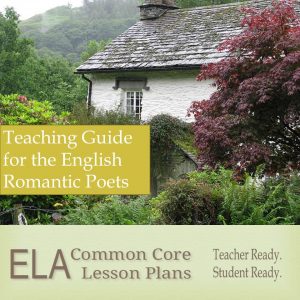Analysis of John Keats’ Odes
Use these John Keats poem interpretations for your next poetry discussion party. You’ll find details on two of his most famous odes, “Ode on Melancholy” and “Ode to a Nightingale.” If you’re looking for an analysis of “Ode on a Grecian Urn,” it deserves its own page.
If you would like step-by-step instructions on how to do a poetry analysis, follow the link.
“Ode to a Nightingale” Analysis

Yes, you can spend multiple class periods on poetry without the dreaded 2-minute reading followed by 49 minutes of stammering. The British Romanticism Teaching Guide includes an overview of British Romanticism and an analysis of selected poems by William Blake, William Wordsworth. Samuel Taylor Coleridge, Lord Byron, Percy Shelley and John Keats.
The following facts and observations were gathered during an analysis of “Ode to a Nightingale” by John Keats.
- Rhyme Scheme: ababcdecde
- Meter: iambic pentameter except for the eighth line of each stanza which is iambic trimeter-why?
- Stanza 1: Poet is depressed (this is a disturbing pattern with Keats). He makes an allusion in line 4 to Lethe, a river flowing from the Greek underworld; it’s also known as the river of forgetfulness, for those who drink from it forget everything. The allusion coincides with one of the themes of the poem, Keats’ desire to forget everything as he listens to a bird sing, or as he writes poetry.
- Stanza 1: Line 5 is an apostrophe to the nightingale whose happiness causes him to “singest of summer in full throated ease” (10). The nightingale is referred to as a “light-winged Dryad of the trees” (7). In Greek Mythology, Dryads are the female spirits of nature (nymphs) who preside over forests and groves. The two mythological references establish a surreal mood-that state between reality and dreaming perhaps. This supports the theme that the poet wants to escape reality, and does.
- Stanza 2: The key word in stanza 2, the item to which Keats refers to as “a draught of vintage that hath been / Cooled a long age in the deep-delved earth / tasting of Flora and the country green” (11-13) is Hippocrene. For those of you who don’t know: In Greek Mythology, Hippocrene is the name of a fountain on Mt. Helicon. It was sacred to the Muses and was formed by the hooves of Pegasus. Drinking the fountain’s water brings forth poetic inspiration.
- Stanza 2: The poet’s desire to drink from the fountain asserts his desire to escape from his problems through poetry: “That I might drink, and leave the world unseen / And with thee fade away into the forest dim” (19-20). Thee in this citation refers to the nightingale.
- Stanza 3: The poet emphasizes his desires in stanza 3, wishing to go with the nightingale who has never experienced the despair and sadness of “The weariness, the fever, and the fret… / Where palsy shakes a few, sad, last gray hairs, / Where youth grows pale, and spectre-thin, and dies / Where but to think is to be full of sorrow” (23-27). It is because the nightingale has never experienced these things that he can sing so beautifully.
- Stanza 4: The poet asserts he will escape life “not charioted by Bacchus… / but on the viewless wings of Poesy” (33). Just in case you hadn’t figured it out, the depressed speaker wishes to escape through poetry. Bacchus is an allusion to the Roman god of wine and revelry.
- Stanza 5: The poet has left the physical world and has entered a world where he sees not with his natural eyes, but with heavenly eyes.
- Stanza 6: The poet begins to snap out of his trance stating his desire to die while listening to the nightingale’s song. He speaks to the bird: “Still wouldst thou sing, and I have ears in vain- / To thy high requiem become a sod” (59-60). The problem with dying is the poet would no longer be able to listen to the nightingale’s song although he claims it would be “rich to die, / To cease upon the midnight with no pain, / While thou art pouring forth thy soul abroad” (55-57). The nightingale’s song is symbolic of Nature’s perfection and reminiscent of poetry.
- Stanza 7: He contrasts the bird with himself. Whereas he is sickly and dying “Thou [the bird] wast not born for death, immortal bird!” (61). More specifically the nightingale’s song is immortal. It has no beginning, having been heard by ancient emporers and by Biblical figures, and in “faery lands forlorn” (70).
- Stanza 8: The word “forlorn” snaps the poet out of his trance. The nighingale has flown and the poet wonders “Was it a vision, or a waking dream?”
“Ode on Melancholy” Analysis

Imagine having 11 complete poetry units with handouts and lesson plans completed. You don’t need to imagine. These units are teacher ready and student ready. Just print, make copies, and accept accolades from colleagues and students.
Rhyme Scheme: ababcdecde
Meter: iambic pentameter
Rhythm: Keats uses Anglo-Saxon derivatives to create a choppy rhythm. The fits and starts imitate the onset of melancholy-that is, moodiness, hyperactivity followed by loss of desire. The second stanza incorporates alliteration and speeds the poem’s rhythm, like an oncoming wave of depression. Keats uses repetition, punctuation, and run-ons to slow the rhythm down. Melancholy, we could say, has set in and is firmly entrenched.
Sound Devices: consonance: “Nor suffer thy pale forehead” (2); assonance: “nightshade, ruby grape” (3), “rosary of yew-berries” (5), “downy owl” (7); “wakeful anguish” (10), “feed deep, deep upon her peerless eyes” (20); alliteration: “fit shall fall” (10), “hides the green hill” (14), “salt sand” (16)
Allusions: Lethe (1) is the river of forgetfulness that comes from Hades, the underworld in Greek mythology; Wolf’s bane (2) is a poisonous plant; Proserpine is the Roman Goddess of the underworld-it’s important to note that Prosepine was kidnapped by Pluto and forced to stay with him for 6 months out of the year much in the same way melancholy forces one to live in spiritual and emotional darkness; Psyche, the mythological lover of Cupid, means soul.
Literary Analysis
- Rhyme scheme: xaxa - it follows a common pattern for quatrains.
- Meter: The first three lines of each stanza are written in iambic tetrameter. The last line is iambic duometer, or a 5 syllable variation. The shortened last line of each stanza marks an abrupt change in rhythm, focusing the reader’s attention.
- Alliteration in line 1 “wretched wight”; consonance in line 3, “palely loitering.”
- Stanzas 1-3: The narrator meets a wretched knight in autumn, who is dying: “I see a lily on thy brow / With anguish moist and fever dew / And on thy cheek a fading rose / Fast withereth too” (9-12). The last lines in these stanzas are sad.
- The poem’s speaker switches in stanza 4 as the knight tells his story: he meets a beautiful fairy woman and they swear their love to one another. The last line in stanzas 4-7 are about the fairy woman.
- There is an abrupt change at the end of stanza 8 as the knight dreams a horrible dream “on the cold hill side” (36): he sees “pale warriors, death pale” agonizing with the knight. They have “starved lips” (41). The knight shares their fate as he wanders aimlessly “on the cold hill side” (48).
- Repetition of the world “pale” represents death.
Analysis Paragraph
John Keats “Ode on Melancholy” describes the oppressive nature of melancholy and depression and its onset. The poet uses harsh Anglo-Saxon words along with consonance and assonance to mimic the starts and fits associated with the onset of depression. He establishes mood with mythological allusions to underworld associations and careful word choice-“nightshade” (4), “sorrow’s mysteries” (8), and “shade to shade” (9). The stanza ends with an ominous declaration that melancholy will “drown the wakeful anguish of the soul” (10).
Keats uses alliteration and end stops to quicken the pace in the second stanza; the stanza, like melancholy, rolls forth, unhindered, “hiding the green hill” (14), “glutting thy sorrow on a morning rose / Or on the rainbow of the salt sand-wave” (15-16). By the third stanza, melancholy is entrenched and the rhythm is slowed through enjambment and interruptive punctuation marks-a dash, semi-colon, or comma. Melancholy’s exsistence proves fatal for Beauty, Joy, and Pleasure. In short, melancholy conquers all.
